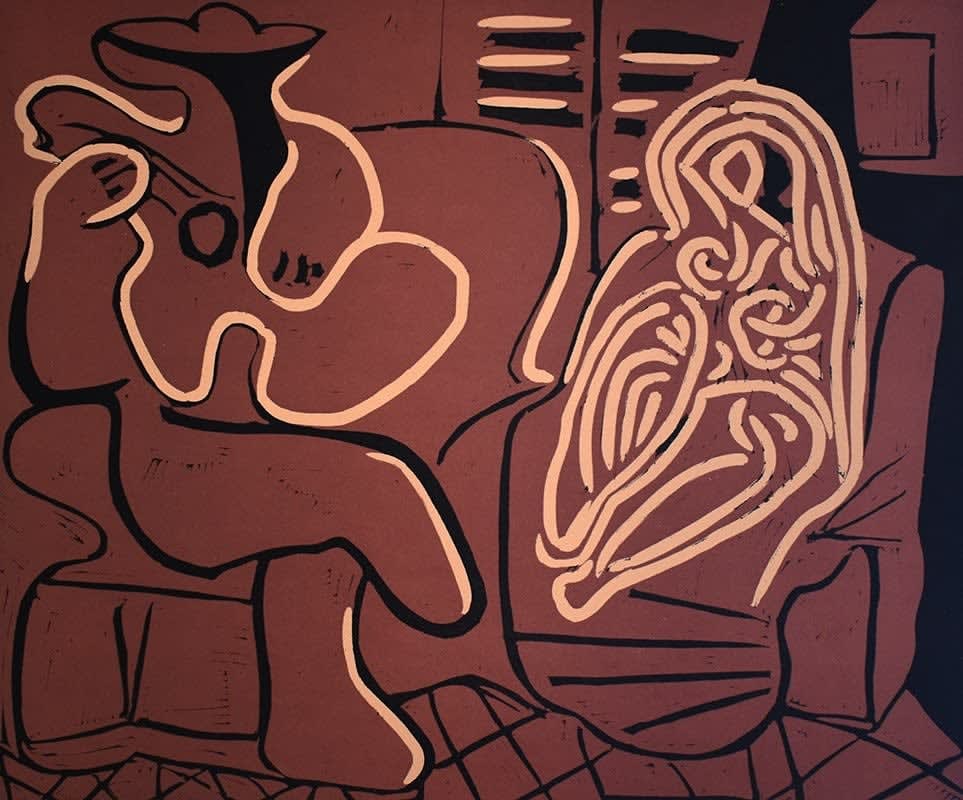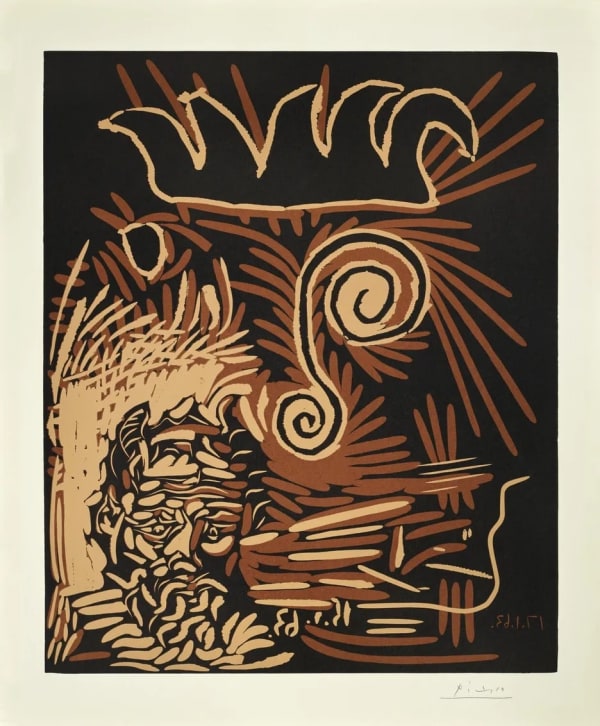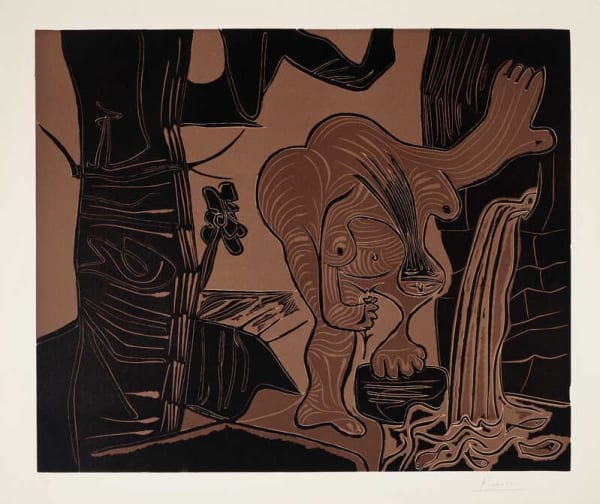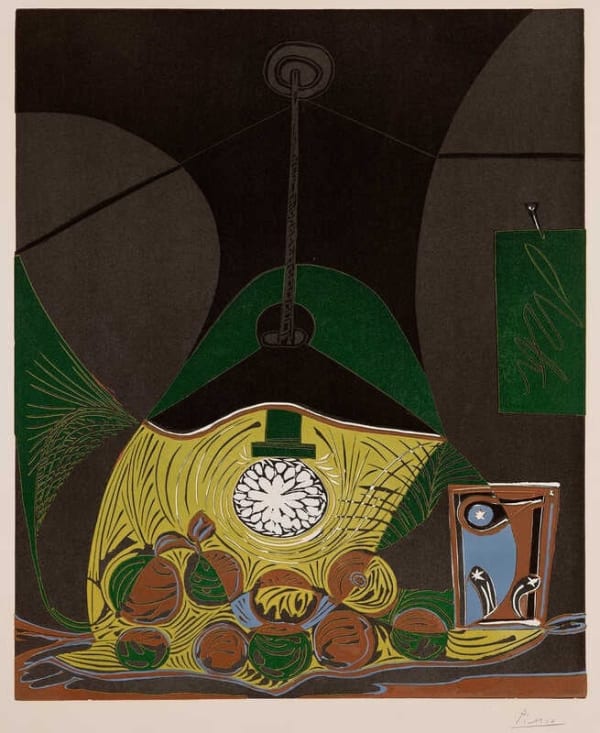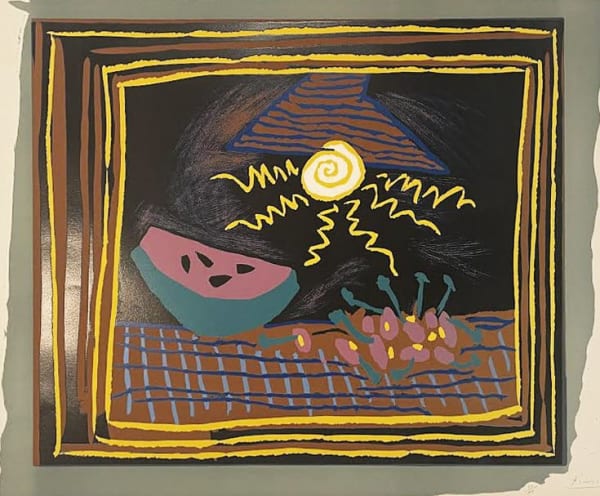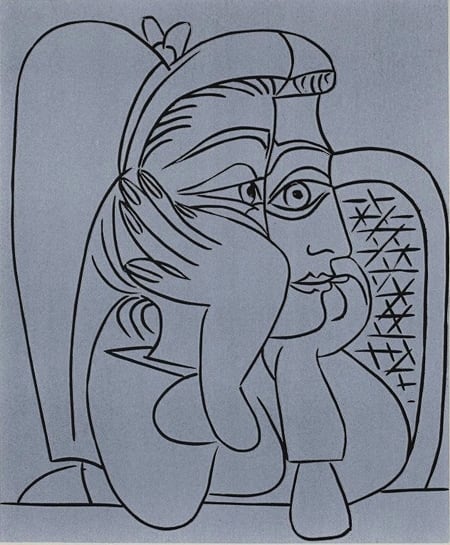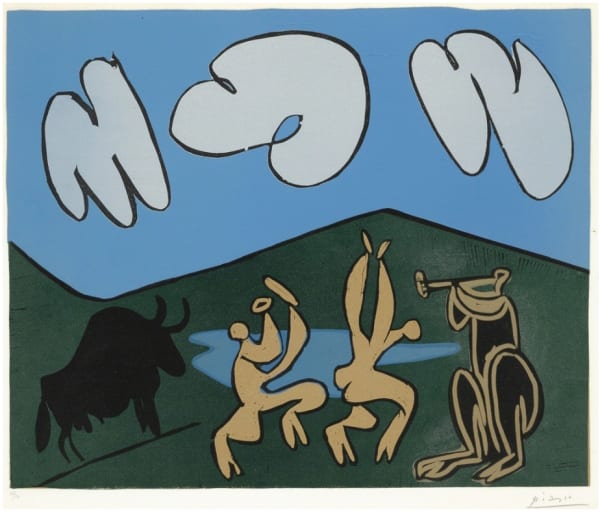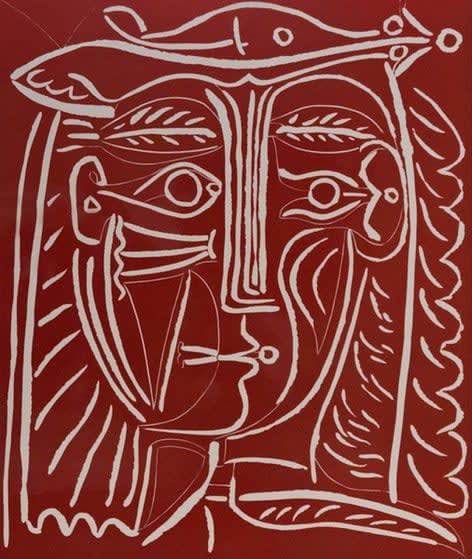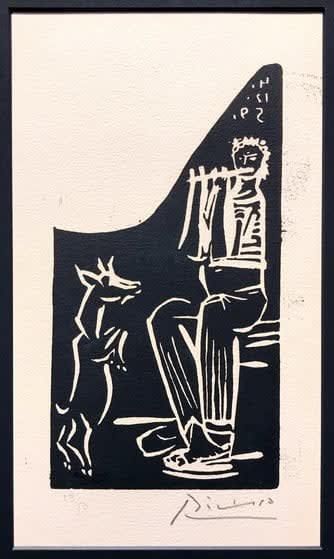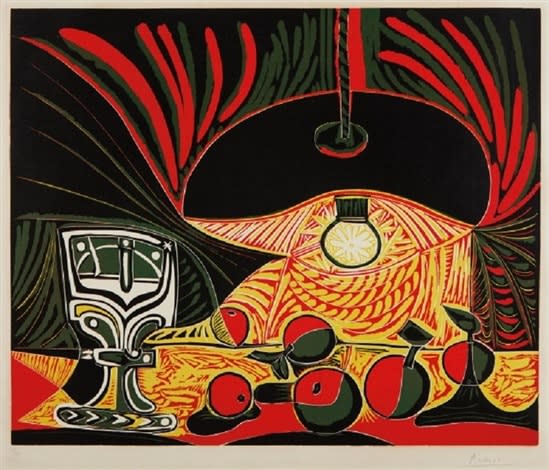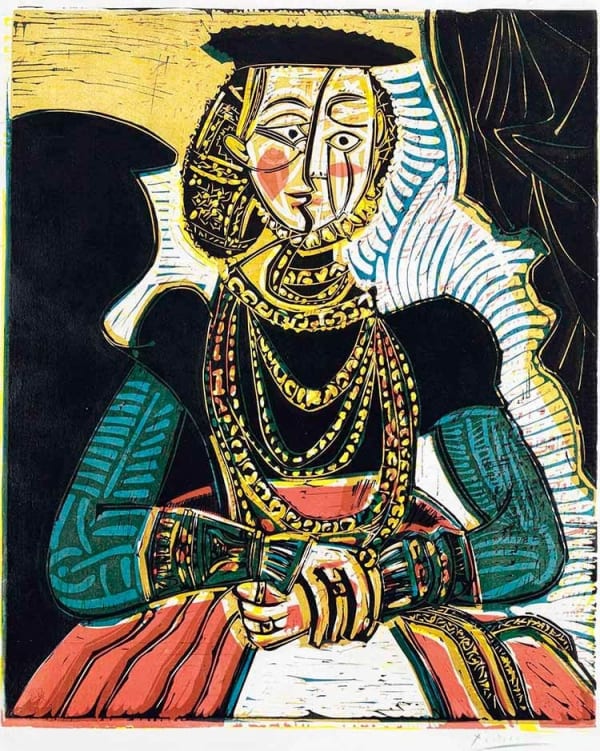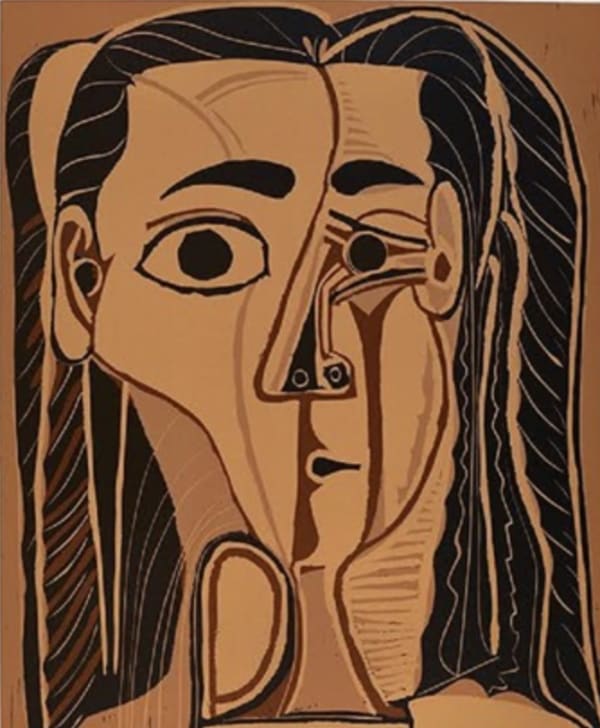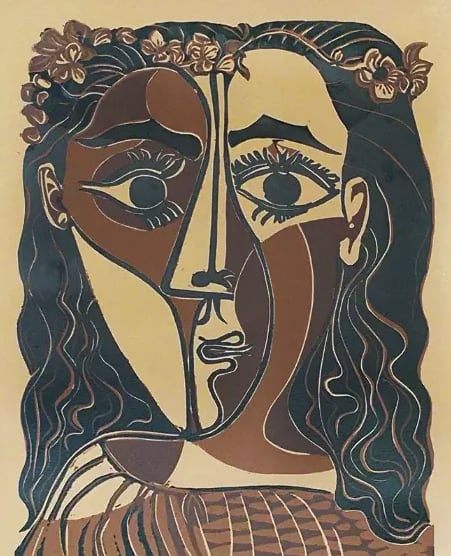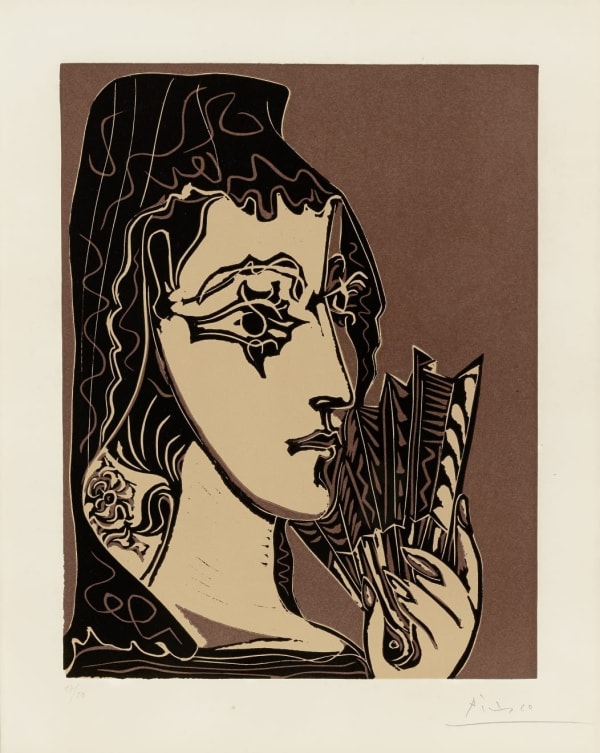-
Artworks

Pablo Picasso
Aubade, with a Woman in an Armchair | L'aubade, avec femme dans un fauteuil, 1959Original Hand Signed and Inscribed Linocut in Colours on Arches Wove Paper62 x 75 cm. / 24.4 x 29.5 in.
Image size: 53.2 x 64.2 cm. / 20.9 x 25.3 in.Edition of 50. Edition of 20 APs.Series: LinocutCopyright The ArtistCreated in 1959, Aubade, with a Woman in an Armchair is a masterful linocut by Pablo Picasso that distills the intimacy of a musical serenade into a bold, abstracted composition....Created in 1959, Aubade, with a Woman in an Armchair is a masterful linocut by Pablo Picasso that distills the intimacy of a musical serenade into a bold, abstracted composition. The title, “Aubade,” refers to a morning song or poem, often one performed for a lover at daybreak. In this print, Picasso translates that poetic concept into a striking visual dialogue between two figures — a musician and a reclining woman — rendered with the confident economy and inventive design that defined his late-career printmaking.
The composition is structured around two main forms: the musician, seated on the left, and the woman, relaxed in an armchair on the right. The musician’s body is reduced to broad, interlocking shapes, outlined in thick black contours that carve into the warm brown surface. His head tilts forward, instrument raised, while his limbs fold into a compact, sculptural arrangement. The simplification is radical: the player’s features are minimal, their body more an arrangement of abstract planes than a literal depiction, yet the posture is instantly legible as one of concentration and performance.
Opposite him, the woman reclines with an air of serene receptiveness. Her figure is defined by a series of swirling, labyrinth-like lines carved into the block, creating a hypnotic interplay of positive and negative space. These looping patterns evoke both the folds of her clothing and the contours of her body, giving her form an almost decorative, tapestry-like quality. This contrast between the musician’s blocky solidity and the woman’s intricate, flowing linework creates a dynamic tension across the composition.
The background is minimal yet carefully structured. The suggestion of a louvered window or shutters behind the woman hints at an interior setting, while the patterned flooring beneath the figures provides a stabilising grid. Picasso uses these architectural cues sparingly, allowing the figures to dominate the visual field.
Technically, Aubade showcases Picasso’s mastery of the linocut medium. By the late 1950s, he had refined his approach to the reduction linocut — a method in which the artist works from a single linoleum block, printing one color at a time and cutting away portions of the block before applying the next layer of ink. This process, sometimes called the “suicide” technique, requires extraordinary foresight, as each cut is irreversible and mistakes cannot be corrected. In Aubade, the reduction process results in a rich layering of the black and brown tones, with the creamy beige of the paper providing the highlights.
The precision of the carving is particularly notable. The lines are crisp, the curves deliberate, and the transitions between broad planes and delicate incisions are handled with complete confidence. Picasso’s ability to balance large, simplified shapes with intricate detail demonstrates his deep understanding of the medium’s potential for both power and nuance.
Thematically, Aubade fits within Picasso’s long-standing interest in the motif of the artist and model, or in this case, the performer and the listener. It is a scene of artistic exchange — one figure creating, the other receiving — rendered without sentimentality but with a palpable sense of connection. The abstracted forms remove the scene from a specific time or place, giving it a timeless, universal quality.
Picasso’s choice to treat the subject through linocut rather than painting or drawing is significant. The medium’s bold contrasts and tactile immediacy heighten the intimacy of the exchange while also giving it a monumental, almost sculptural presence. In doing so, Picasso demonstrates how printmaking, far from being a secondary art form, could hold its own as a primary vehicle for his creative vision.
Ultimately, Aubade, with a Woman in an Armchair is a testament to Picasso’s dual mastery as both an innovator and a craftsman. It embodies the distilled clarity of his late style — where every line and shape serves a purpose — and the technical brilliance that allowed him to transform a block of linoleum into an image at once intimate and enduring. It is not merely a depiction of a serenade, but an embodiment of the artistic act itself: the offering of one’s art to another, rendered with the authority and inventiveness of one of the 20th century’s greatest printmakers.
For more information on L’aubade, avec femme dans un fauteuil by Pablo Picasso for sale, contact our galleries using the form below.
%3Cdiv%20class%3D%22artist%22%3EPablo%20Picasso%3C/div%3E%3Cdiv%20class%3D%22title_and_year%22%3E%3Cspan%20class%3D%22title_and_year_title%22%3EAubade%2C%20with%20a%20Woman%20in%20an%20Armchair%20%7C%20L%27aubade%2C%20avec%20femme%20dans%20un%20fauteuil%3C/span%3E%2C%20%3Cspan%20class%3D%22title_and_year_year%22%3E1959%3C/span%3E%3C/div%3E%3Cdiv%20class%3D%22medium%22%3EOriginal%20Hand%20Signed%20and%20Inscribed%20Linocut%20in%20Colours%20on%20Arches%20Wove%20Paper%3C/div%3E%3Cdiv%20class%3D%22dimensions%22%3E62%20x%2075%20cm.%20/%2024.4%20x%2029.5%20in.%20%3Cbr/%3E%0AImage%20size%3A%2053.2%20x%2064.2%20cm.%20/%2020.9%20x%2025.3%20in.%3C/div%3E%3Cdiv%20class%3D%22edition_details%22%3EEdition%20of%2050.%20Edition%20of%2020%20APs.%3C/div%3E%3Cdiv%20class%3D%22series%22%3E%3Cspan%20class%3D%22artwork_caption_prefix%22%3ESeries%3A%3C/span%3E%20Linocut%3C/div%3E12of 12Related artworks-
 Pablo PicassoTwo Women by the Window | Deux femmes près de la fenêtre, 1959
Pablo PicassoTwo Women by the Window | Deux femmes près de la fenêtre, 1959 -
 Pablo PicassoWoman Reclining and Man with a Guitar | Femme couchée et homme à la guitare, , 1959
Pablo PicassoWoman Reclining and Man with a Guitar | Femme couchée et homme à la guitare, , 1959 -
 Pablo PicassoJacqueline au chapeau de paille, 1962
Pablo PicassoJacqueline au chapeau de paille, 1962 -
 Pablo PicassoLe Vieux bouffon, 1963
Pablo PicassoLe Vieux bouffon, 1963 -
 Pablo PicassoHomme au batôn / Le Vieux bouffon, 1963
Pablo PicassoHomme au batôn / Le Vieux bouffon, 1963 -
 Pablo PicassoFemme nue à la source, 1963
Pablo PicassoFemme nue à la source, 1963 -
 Pablo PicassoNature morte à la suspension, 26 mars, 1962
Pablo PicassoNature morte à la suspension, 26 mars, 1962 -
 Pablo PicassoTaureau et Picador, 1959
Pablo PicassoTaureau et Picador, 1959 -
 Pablo PicassoFemme au Chapeau (Portrait de Jacqueline au chapeau de paille multicolore)., 1962
Pablo PicassoFemme au Chapeau (Portrait de Jacqueline au chapeau de paille multicolore)., 1962 -
 Pablo PicassoLe Déjeuner sur l'herbe d'aprés Edouard Manet. (The Luncheon on the Grass after Edouard Manet), 1954
Pablo PicassoLe Déjeuner sur l'herbe d'aprés Edouard Manet. (The Luncheon on the Grass after Edouard Manet), 1954 -
 Pablo PicassoBoy with a Crown of Leaves | Jeune homme couronné de feuillage, 1959
Pablo PicassoBoy with a Crown of Leaves | Jeune homme couronné de feuillage, 1959 -
 Pablo PicassoLe Vieux Roi (B. 1152) (The Old King) , 1963
Pablo PicassoLe Vieux Roi (B. 1152) (The Old King) , 1963 -
 Pablo PicassoNature Morte a la Pasteque, 1962
Pablo PicassoNature Morte a la Pasteque, 1962 -
 Pablo PicassoFemme Accoudée (Bloch 922) , 1959
Pablo PicassoFemme Accoudée (Bloch 922) , 1959 -
 Pablo PicassoLes vendangeurs, 1959
Pablo PicassoLes vendangeurs, 1959 -
 Pablo PicassoL'Aubade, avec Femme Accoudee, 1959
Pablo PicassoL'Aubade, avec Femme Accoudee, 1959 -
 Pablo PicassoJacqueline au Bandeau, 1962
Pablo PicassoJacqueline au Bandeau, 1962 -
 Pablo PicassoWatermelon Still Life, 1962
Pablo PicassoWatermelon Still Life, 1962 -
 Pablo PicassoDeux Femmes Prés de la Fenêtre , 1959
Pablo PicassoDeux Femmes Prés de la Fenêtre , 1959 -
 Pablo PicassoBacchanale au Hibou (bloch 938), 1959
Pablo PicassoBacchanale au Hibou (bloch 938), 1959 -
 Pablo PicassoBacchanale au Taureau Noir (Bloch 935), 1959
Pablo PicassoBacchanale au Taureau Noir (Bloch 935), 1959 -
 Pablo PicassoTête de Femme au Chapeau , 1962
Pablo PicassoTête de Femme au Chapeau , 1962 -
 Pablo PicassoFaune et Chévre, 1959
Pablo PicassoFaune et Chévre, 1959 -
 Pablo PicassoPortrait de Femme a la Fraise et au Chapeau , 1962
Pablo PicassoPortrait de Femme a la Fraise et au Chapeau , 1962 -
 Pablo PicassoL'Etreinte (Bloch 1150), 1963
Pablo PicassoL'Etreinte (Bloch 1150), 1963 -
 Pablo PicassoNu Assis, 1962
Pablo PicassoNu Assis, 1962 -
 Pablo PicassoPortrait De Jacqueline (Bloch 923), 1959
Pablo PicassoPortrait De Jacqueline (Bloch 923), 1959 -
 Pablo PicassoPortrait de Jacqueline Au Chapeau De Paille Fleuri, 1962
Pablo PicassoPortrait de Jacqueline Au Chapeau De Paille Fleuri, 1962 -
 Pablo PicassoLa Pique en Rouge et Jaune (The Bullfight in Red and Yellow), 1959
Pablo PicassoLa Pique en Rouge et Jaune (The Bullfight in Red and Yellow), 1959 -
 Pablo PicassoJacqueline au Bandeau, 1962
Pablo PicassoJacqueline au Bandeau, 1962 -
 Pablo PicassoNature Morte Au Verre Sous La Lampe, 1962
Pablo PicassoNature Morte Au Verre Sous La Lampe, 1962 -
 Pablo PicassoBuste de Femme d'après Cranach le Jeune, (Bloch 859), 1958
Pablo PicassoBuste de Femme d'après Cranach le Jeune, (Bloch 859), 1958 -
 Pablo PicassoPortrait de Jacqueline Accoudée, 1959
Pablo PicassoPortrait de Jacqueline Accoudée, 1959 -
 Pablo PicassoGrande Tete De Femme (Bloch 1069), 1962
Pablo PicassoGrande Tete De Femme (Bloch 1069), 1962 -
 Pablo PicassoPetite Tête de Femme Couronnée, `962
Pablo PicassoPetite Tête de Femme Couronnée, `962 -
 Pablo PicassoPortrait de Jacqueline en Carmen (L'Espagnole) , 1962
Pablo PicassoPortrait de Jacqueline en Carmen (L'Espagnole) , 1962
-
Join our mailing list
* denotes required fields
We will process the personal data you have supplied in accordance with our privacy policy (available on request). You can unsubscribe or change your preferences at any time by clicking the link in our emails.
This website uses cookies
This site uses cookies to help make it more useful to you. Find out more about cookies.
